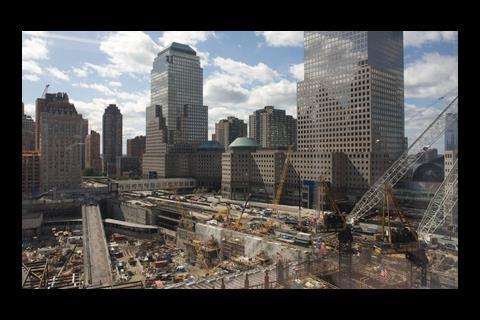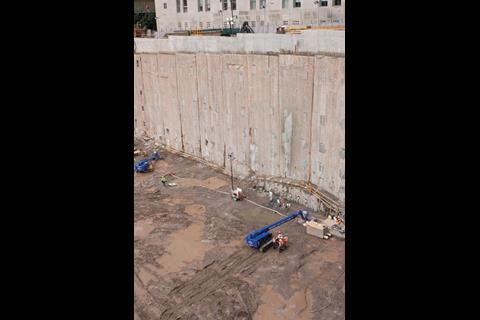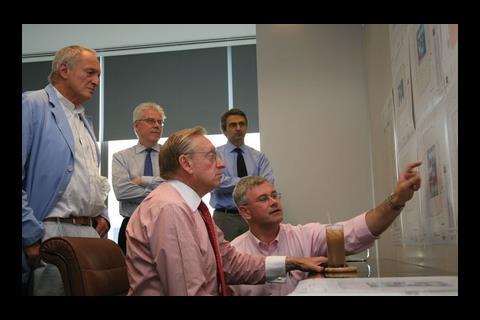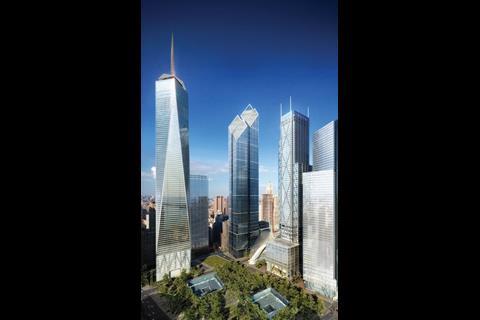After the bravura of the original construction and the tragedy of its destruction, comes the drama of the rebuilding of the World Trade Centre. Emily Wright went on site to see work in progress
New Yorkers refer to the gap in the Manhattan skyline where the twin towers once stood as “the dip” – apt for a city that is at the heart of the country’s, and arguably the world’s, economic crisis. But the reason behind this particular dip is one that sent shockwaves around the world greater even than the collapse of the mortgage market. It is a constant reminder of the day when more than 3,000 people lost their lives and 50 years of structural history was razed to the ground in just two hours.
But now, seven years and two months on from 9/11, those entrusted with the World Trade Centre (WTC) reconstruction have come under criticism as there is still no sign of anything emerging from the ashes to fill the gap. “I look over the Hudson every day on my way to work at where the towers used to be and I can’t believe there is still nothing there,” says one Brooklyn businessman. “All the rows, the politics, the fights and delays. It’s insulting to those who lost their lives that the reconstruction has become such a bureaucratic nightmare.” The $18bn (and rising) question remains, how long is it going to take?
On the face of it, things don’t look good. On 2 October, the project’s main client, the Port Authority of New York and New Jersey announced that the cost of the project could rise by $1bn and some parts of the scheme might suffer delays of up to five years. Chris Ward, Port Authority’s executive director, prefaced a report on the future of the site with a letter of apology to the governor of New York state: “We found no rewind button that could take us back in time or reverse the trajectory of the past seven years,” he said. “With projects already under way, billions of dollars already committed and foundations already built, it is impossible and impractical to turn the clock back.”
But on the same day that the announcement was released, the structural engineers who have been working night and day to overcome the technical and structural challenges of this project took Building onto the site to show that this story is one not just of destruction and delay but also of success, regeneration and world-class innovation in structural engineering.
The challenges
Over the past seven years, architects, engineers and contractors have been working together on the project to address challenges that most of them have never come up against before. The uniqueness of the project, and its sheer scale, have made for a bumpy ride – it is an immense 16-acre site containing 26 individual projects. There are 23 stakeholders and political and architectural squabbles slowing up the construction process.
Some of the most difficult challenges occurred early on and had to be overcome to allow the construction process to get under way. “Look to the centre of the site,” says Jeffrey Smilow, executive vice-president of WSP Cantor Seinuk, the company responsible for most of the structural engineering on the project. “You can see it is bisected by Greenwich Street. What is being done now is that on the left side towers 2, 3 and 4 are being positioned and on the other side there will be the memorial pools, in the position of the original twin towers, and the Freedom Tower.”
He is pointing out these key areas from the 10th floor of the neighbouring 7 World Trade Centre tower which overlooks Ground Zero. Although an actual muddy boots site visit is to come, the engineers insist that the only way to see the site properly is from this bird’s eye view. And they have a point. Although there are about 750 site workers on the ground, a figure that is expected to rise to 4,400 in 2011 and 2012, their bright red and green hard hats look lost in the cavernous crater. Excavations 80ft down have almost been completed on one side of the site and so the distances between workers can be immense, and are as deep as they are wide. The only way that some workers can attract the attention of others is by using foghorns.
The bathtub
In order to successfully achieve the 80ft excavation to the granite bedrock of Manhattan, a system called “the bathtub” had to be devised by WSP Cantor Seinuk and Port Authority engineers. The need for this innovation came about because the site is so close to the Hudson river that the water table is only a few feet below ground level.
There was a brief discussion about draining the Hudson before a less time consuming solution was thought up: to create a ring of concrete on the east side of the site where towers 2, 3 and 4 are positioned to match a similar tub already in existence on the west side. So 4ft-wide trenches were dug to the bedrock and filled with bentonite, a clay that acts as a natural sealant. Every 22ft, a seven-storey steel framework was inserted and concrete was pumped to the bottom of the trench. In this way, the trenches were filled from the bottom up and the bentonite slurry removed from the top. The excavation that followed was unprecedented owing to its sheer size: some 400,000 tonnes of concrete, soil and rock was removed.
The result is a ring of concrete that goes down to the bedrock. This allows excavation to take place and will keep the developments’ basements dry. Indeed, the creation of the east bathtub has allowed for five storeys of development below street level or “an underground city” that has never been possible on the site before. This city includes a retail complex, car parks and the 9/11 memorial museum.
When it came to engineering the bathtub, things got complicated. It could not be designed simply to match the west bathtub owing to the bisected site and the discovery that there were different water pressures and lateral forces on each side. Coming up with a solution to this challenge, which was one of the most complex on the project, was put in the hands of Ahmad Rahimian, WSP Cantor Seinuk’s president.
Rahimian explains the differences between these two tubs: “The west bathtub was built during original construction of the World Trade Centre, however we have reanalysed it and reinforced it with an additional concrete wall for the new design. The east bathtub is brand new. The hydrostatic pressures of the soil and water is the key design issue that has been studied and designed.”
And his colleague Silvian Marcus, WSP Cantor Seinuk’s chief executive, explains how crucial it is that these measurements are spot on: “Any failure of the tub in the future and the water could rush in and flood the spaces below street level. That would also mean it would flood the mechanical plant supplying the electricity, heating and cooling systems and the subway. This is very sensitive and the Port Authority gave it to Ahmad to engineer. They are relying on us to deliver a safe product.”
The concrete cores
As if the immense pressure of being responsible for making sure there is no chance of flooding was not enough, WSP Cantor Seinuk has also been entrusted with the structural engineering on the Freedom Tower (tower 1), towers 2 and 3, and tower 7 World Trade Centre, which has already been built and has become the structural blueprint on which all the other towers will be based.
The key challenge with the actual erection of these towers, and one that has been overcome on 7 World Trade Centre, is that although concrete cores are standard in the UK, owing to labour restrictions they are not used on a regular basis in New York. These union restrictions state that a concrete core can not go up ahead of the steel frame.
But after the progressive collapse seen on 9/11, it was decided that a reinforced concrete core would be introduced into every new tower on the site. A way around the restrictions would have to be worked out.
The solution was that the steel structuring was constructed and then pulled away from the building’s column lines, creating a gap to allow a self-jacking framework system to be used to build the concrete core. The steel erection therefore progressed some eight floors ahead of the concrete core as the tower grew. This meant that labour restrictions were not broken.
The finished core running through the centre of 7 World Trade Centre starts off with 24-inch walls at the base of the structure tapering to 18 inches at the top and houses emergency exits and stairwells that have been widened to ensure quicker evacuation. “It was hard to engineer the concrete core in the US,” says Marcus. “But we learned from 9/11 and so when we engineered these towers we created a new standard for how buildings should be designed in New York with the addition of the core.”
Extra strength
It is hardly surprising that safety and security have been high on the agenda when designing the new towers. All of them will have a steel frame with added redundancy – meaning that the structure is designed and built with more resilience. It means that the building will not collapse if one or several columns are removed or destroyed in some way. Exactly how many columns would need to be taken away before the building collapsed is shrouded in secrecy. Only those who designed the system and a few chosen others know the calculations: “The rigid frame is made out of columns and these, plus the connections between the beams and the frame, add redundancy in case of damage to one or more columns,” says Marcus. “The system is good.”
On site at the moment most of the activity is concentrated on the Freedom Tower, the east bathtub, the memorial and museum, towers 3 and 4 and the Deutsche Bank demolition that will make way for the vehicle security centre.
On Tower 1 (the Freedom Tower designed by David Childs of Skidmore, Owings & Merrill) the concrete has been poured for the steel columns at the base of the structure and you can just about see the concrete core beginning to take shape that will contain the towers elevators and fire escapes.
Over on the east side of the site, workers are doing double shifts to finish the excavation required for tower 2, and concrete pours are continuing for tower 4.
But there is still relatively little to see above ground and so to get an idea of what these projects may look like in the future, it is necessary to look just a few feet over the road to the completed 7 World Trade Centre. The original building on the site also collapsed in the terrorist attacks, but was rebuilt within six years as a gleaming tower that has become the structural blueprint for all the other towers – and a success story to emulate.
One of the forgotten casualties of 9/11, 7 World Trade Centre caught fire when the north tower collapsed at 10.28am – 106 minutes after being hit by American Airlines Flight 11. All of Manhattan’s firefighters were occupied in trying to rescue people from the rubble of the twin towers, so 7 World Trade Centre was left to burn for more than six hours before its crumbled to the ground.
The reason this particular building was completed so quickly – construction started in May 2002 and was finished in 2006 – has to do with the fact that the original 47 storeys were built on top of the power substation that provides, electricity for most of downtown Manhattan.
“Wall Street was without electricity,” says Marcus. “Power was shipped from New Jersey on a temporary basis, but the livelihood of the whole area was resting on this substation, so that drove a speedy reconstruction. The government called Larry Silverstein and the mayor almost immediately to push for this building to go up fast.”
Since its completion in 2006, 7 World Trade Centre has been billed as the safest skyscraper in the US; it meets security and energy codes that have not been written, and goes far beyond what is required by US law. It is also a remarkably cost-effective and sustainable building, and has been named the first green office tower in New York after gaining gold status in the US Green Building Council’s LEED program. Not a bad advert for what is still to come and the towers which will eventually fill that dip in the Manhattan skyline.

Main delays and cost overruns
Original print headline - The neverending story
Project teams
Client Port Authority of New York & New Jersey
Developer Silverstein Properties
Freedom Tower
Architect Skidmore, Owings & Merrill
Structural engineer WSP Cantor Seinuk
M&E engineer Jaros Baum & Bolle
Tower 2
Architect Foster + Partners
Structural engineer WSP Cantor Seinuk
M&E engineer Jaros Baum & Bolle
Tower 3
Architect Rogers Stirk Harbour + Partners
Structural engineer WSP Cantor Seinuk
M&E engineer Jaros Baum & Bolle
Tower 4
Architect Maki and Associates
Structural engineer Leslie E Robertson
M&E engineer Jaros Baum & Bolle
Timeline
11 September 2001 The attacks on the twin towers.
May 2002 Workers conclude the recovery effort at Ground Zero. In eight-and-a-half months, 1.8 million tons of debris have been moved to the Fresh Kills landfill on Staten Island. On 28 May, the final girder from the World Trade Centre is removed.
July 2002 Six concept plans are released for the design of the site; press criticism later forces the process to be restarted.
December 2002 Nine new plans are shortlisted.
February 2003 Daniel Libeskind’s plan is announced the winner.
December 2003 Libeskind’s masterplan proposal for a series of spiralling or descending towers is finalised but comes under heavy criticism.
July 2004 Libeskind and the scheme’s developer, Larry Silverstein, go to court after Libeskind files a lawsuit claiming Silverstein owes him $843,750 in design fees. Silverstein agrees to pay $370,000.
Early 2005 The New York Police Department calls for the Freedom Tower to be redesigned for security reasons. David Childs takes on the job
March 2006 Workers arrive on site to start surveying work.
May 2006 Richard Rogers and Fumihiko Maki are announced the architects for towers 3 and 4 respectively. Seven World Trade Centre is officially opened.
April 2006 Construction work starts on Tower 1, the Freedom Tower.
October 2008 The World Trade Centre Report: A Roadmap Forward is released, detailing delays and cost overruns on the scheme.
Downloads
What’s where
Other, Size 0 kb
New York

The city where the future happens first
- 1
- 2
- 3
- 4
- 5
- 6
 Currently
reading
Currently
reading
The neverending story: On site at Ground Zero
- 8













































No comments yet